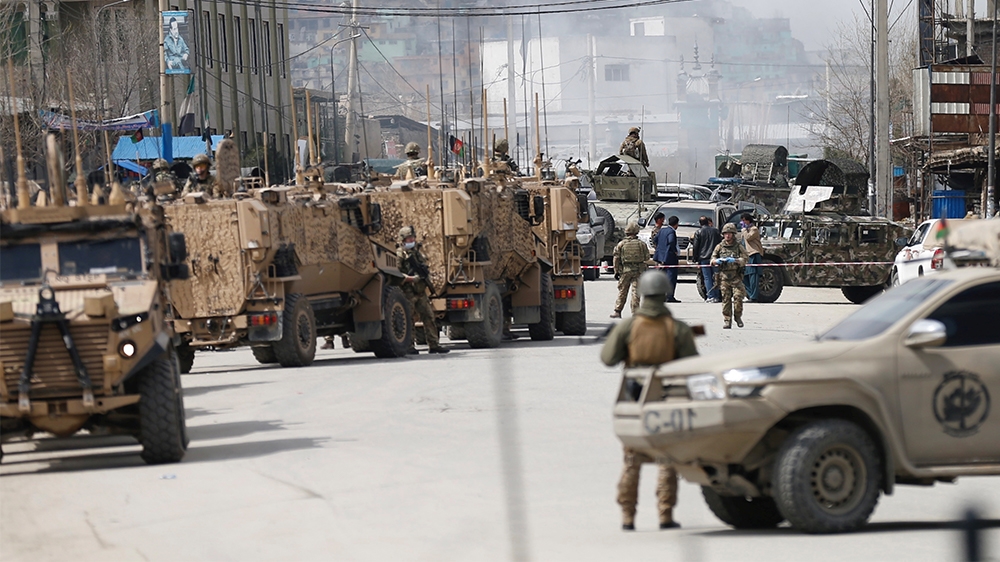Gunmen and suicide bombers have stormed a Sikh religious complex in the Afghan capital Kabul and were locked in a continuing battle with security forces, the Ministry of Interior has said.
Security forces cordoned off the area, located in old Kabul, and were trying to counter the attack, which began at 7:45am local time, Ministry of Interior spokesman Tariq Arian said in a message to journalists.
More:
"People are stuck inside the building and (security forces) are trying to rescue them," Arian told AFP news agency.
Narindra Singh Khalsa, a parliamentarian from the minority Sikh community, told AP news agency he had been near the Gurdwara - the Sikh place of worship - when the attack happened and ran to the site. He said at least four people were killed.
Those killed included a child whose body was brought to a Kabul hospital, emergency services and the hospital said. At least seven people were wounded.
The interior ministry said the first floor of the Gurdwara had been cleared and Afghan special forces, aided by international troops, were moving slowly throughout the remainder of the building.
Security forces had cordoned off the area, located in old Kabul (Rahmat Gul/AP Photo]
ISIL claims responsibility
At a Kabul hospital, Mohan Singh, who was in the Gurdwara when the attack began, told AP he first heard the sound of gunshots and dove for cover under a table. Later, he heard the sound of explosions, adding that he believes they were hand grenades. He was injured when parts of the ceiling fell on him.
In photographs shared by the interior ministry, about a dozen children were seen being rushed out of the Gurdwara by Afghan special forces, many of them barefoot and crying.
Khalsa later told Reuters News Agency that many people were still inside the building. "The gunmen started their attack at a time when the Dharamsala was full of worshippers," he said, referring to a sanctuary area in the temple compound.
Another Sikh member of parliament said there were "about 150 people inside the temple".
"Some people inside the temple are hiding, and their phones are off. I am very concerned," Anarkali Kaur Honaryar told AFP news agency.
The Taliban denied any involvement in the attack. But the SITE Intelligence Group, which tracks activities by armed groups, said the ISIL (ISIS) armed group had claimed responsibility for the attack on its Aamaq media arm.
Earlier this month, an affiliate of the ISIL attacked a gathering of minority Shia Muslims in Kabul, killing 32 people.
Sikhs in Afghanistan
The attack comes a day after the US said it would cut its aid to the Afghan government by $1bn over frustrations that feuding political leaders could not reach an agreement and form a team to negotiate with the Taliban.
US Secretary of State Mike Pompeo visited Kabul on Tuesday in a bid to resolve a standoff between President Ashraf Ghani and his rival Abdullah Abdullah, who also proclaimed himself president following a contested election.
The US and the Taliban signed a deal last month that was supposed to pave the way for talks between the Afghan leadership and the rebels, but with Kabul unable to agree on who is in government, the talks have stalled.
Sikhs, who number fewer than 300 families, have suffered widespread discrimination in the country and have also been targeted by armed groups.
In 2018, a suicide bombing targeting the Sikh community and claimed by ISIL killed more than a dozen people in the eastern city of Jalalabad.
Under Taliban rule in the late 1990s, Sikhs were asked to identify themselves by wearing yellow armbands, but the rule was not enforced.
In recent years, large numbers of Sikhs and Hindus have sought asylum in India, which has a Hindu majority and a large Sikh population.
Afghan security forces at the site of the attack in Kabul [Mohammad Ismail/Reuters]
Let's block ads! (Why?)
https://news.google.com/__i/rss/rd/articles/CBMieGh0dHBzOi8vd3d3LmFsamF6ZWVyYS5jb20vbmV3cy8yMDIwLzAzL2d1bm1lbi1hdHRhY2stc2lraC1yZWxpZ2lvdXMtY29tcGxleC1rYWJ1bC1pbnRlcmlvci1taW5pc3RyeS0yMDAzMjUwNDQ5MDU1MjIuaHRtbNIBfGh0dHBzOi8vd3d3LmFsamF6ZWVyYS5jb20vYW1wL25ld3MvMjAyMC8wMy9ndW5tZW4tYXR0YWNrLXNpa2gtcmVsaWdpb3VzLWNvbXBsZXgta2FidWwtaW50ZXJpb3ItbWluaXN0cnktMjAwMzI1MDQ0OTA1NTIyLmh0bWw?oc=5
2020-03-25 08:34:00Z
52780687282826





